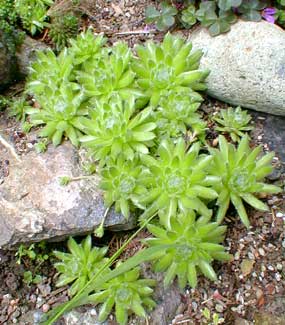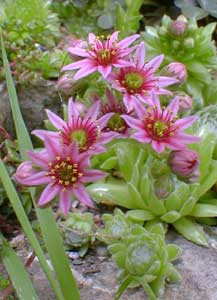
Pale Green
Sempervivum tectorum
Hen & Chicks
"Old wryters do call it Iovis barba, Iupiter's Bearde, & holde an Opynion supersticously that in what house so ever it groweth, no Lyghtning or Tempest can take place to doe any harm there."
-William Bullein,
1562
1562
We obtained tiny starts of two distinctly labeled pale green houseleeks from a charming little nursery in Tacoma which specializes both in unusual bog plants & in succulents.
They were very specifically identified as two different houseleeks of the Jovibarba genus, one purportedly Jovibarba allionii x hirta 'Bilansky Tatra,' & the other Jovibarba globifera allionii.
Unfortunately, they were mislabeled, & as expertise of specialists is not invariably reliable.
 If they had been the Jovibarba spp, they would have had greenish white or yellow flowers. It was a couple years before the two small plantings had spread up & down a miniature rockery, reaching out to one another blending into a single continuous spread. And that whole while they had very much the look of Jovibarbas, so I never doubted they were what they were labeled as being, until they bloomed two years later & had the rose-pink flowers of Sempervivum tectorum, as shown in a June portrait below.
If they had been the Jovibarba spp, they would have had greenish white or yellow flowers. It was a couple years before the two small plantings had spread up & down a miniature rockery, reaching out to one another blending into a single continuous spread. And that whole while they had very much the look of Jovibarbas, so I never doubted they were what they were labeled as being, until they bloomed two years later & had the rose-pink flowers of Sempervivum tectorum, as shown in a June portrait below.Jovibarba & Sempervivum are so similar in appearance, & each has such variation even within a single species of each genus, that it is understandable that even a specialty nursery might become confused. To be sure, at first glance, the leaves of these pale green forms more resembled Jovibarba hybrids than Sempervivum. Jovibarba has a greater tendency toward the pale green coloration, while Semps more often have at least reddish hues. Jovi more often has the delicate elongated petals, Semp is more often fat-leafed. So to great extent, the mislabeling is understandable. But when they bloom, there is no longer any leeway for confusion.
As a garden escapee, this native of the French & Italian Alps naturalized in many temperate regions around the globe, including in Canada & New England. Although temeprate zones suit it best, as a garden plant it thrives in most zones, from subalpine or subarctic to nearly desert conditions.
It prefers bright shade & in warmer zones needs considerable protection from too direct a sunlight. Even in our moderate temperate area, the palest green varieties such as this one are easily damaged by too much sun. It can tolerate droughtiness but prefers soil that does not completely dry out too often.
Poor drainage or overwatering will kill it, though not much else will. Before these were put together in the miniature rockery, they were planted in dark wet areas where they were slowly wasting away, but when I got them to dappled shade & more importantly to a swift-draining soil, they began spreading delightuflly.
Houseleeks are frequently called "Hen & Chicks" because there will be a number of smaller rosettes developing around a mature rosette. With this particularly pale green houselee, however, the rosettes tend swiftly to become all the same size, about two inches each. The lack of "chicks" causes me to prefer, for this variety, the primary name Houseleek, or else Jupiter's Beard.
Both Sempervivum spp & Jovibarba spp are commonly called Jupiter's Beard, Jove's Beard, Thor's Beard, Donarsbart or Dondarsbaart. Among Germanic people, houseleeks were sacred to the god Thor, or the earlier divinity Donar who was absorbed into Thor's cult. The conquering Romans identified this god with Jupiter. Hence the names alluding to the beard of the Great God. These succulents have also been called Jupiter's Eye; or, because Jupiter can take the form of a bull, Bullock's Eye, after the round shape of the rosettes. The folk-name Devil's Beard is a Christian recasting of the pagan god.
The "beard" was perceived in the flowers, the thick stem providing foremost a phallic impression, & while only buds on an upright rod, very much reminiscent of the artificial beard worn by pharaohs as proof of sovereignty. Jupiter or Thor presumedly had just such a beard, as also the Egyptian Ammon-Ra. The round rosette of leaves was furthermore a reflection of the Sun-disc of Ammon, whom the Romans identified with Jupiter.
Antiquated names for houseleeks include "Aaron's Rod" referring to the magical phalicism of the thick-stemmed flowers, & "Semen of Ammon" because they were thought to have erupted from the spilled seed of the oracular Sun-god of Thebes & Egypt, just as clovers were the Semen of Ares, hellebores the Semen of Helios, & so on. The plant was further associated with the forbidden divinity Milcom, a biblical God of Fire worshipped by the Children of Ammon. Houseleeks were thus born of "Fire" both of the sun, & of lightning, & had power over fire.
These associations with divinities of thunder, lightning, fire, or the sun, were also gods of male potency; & as Jove's Beard was also thought to be an aid in the fruitiveness of Freya, the plant was simultaneously thought to increase the number of children in a household. In Dorset, England, houseleeks were called "Welcome Husband" or more fully "Welcome-Home-Husband-Though-Never-So-Drunk." The presence of houseleeks was believed to heighten virility. They were eaten by the man of the house as an acrid spice mixed with meats, both the meat & the houseleek thought to be just the thing for heightening sexual vigor.
Because Thor or Jupiter had rule of lightning, these Thunderplants were grown on the roofs of houses from earliest medieval & perhaps ancient times, in the belief that they protected the house from lightning strikes. Their amazing capacity to thrive & spread in minimal soil means they can even get a foothold in slate roofs with hardly more than an accumulation of dust to sustain them.
In Slavic nations, the tradition of roof-top houseleeks is still practiced. At first glance this seems like it should be a baseless superstition, but if indeed a thatch roof, inordinantly susceptible to fire, were covered with moist succulents, even if lightning did strike, there would be a vastly reduced possibility of cumbustion. The spiked rosette is said additionally to disperse positively charged particles that attract lightning's negative charge. So I've small doubt but that many a house has been saved by houseleeks.
The name Houseleek, or Roof Houseleek, does not mean a that this practice causes roofs to leek, but alludes to the plant as a roof onion. The acrid vegetable on the roof was especially handy when actual onions (leeks) were out of season, for evergreen houseleeks were available year-round. Tender young leaves can be eaten raw as a salad addition. The leaves have also been used to make a drink similar to lemon-aid.